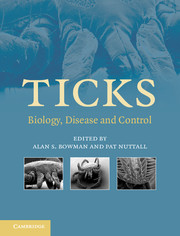Book contents
- Frontmatter
- Contents
- List of contributors
- Preface
- 1 Systematics and evolution of ticks with a list of valid genus and species names
- 2 The impact of tick ecology on pathogen transmission dynamics
- 3 Tick salivary glands: the physiology of tick water balance and their role in pathogen trafficking and transmission
- 4 Tick saliva: from pharmacology and biochemistry to transcriptome analysis and functional genomics
- 5 Tick toxins: perspectives on paralysis and other forms of toxicoses caused by ticks
- 6 Tick lectins and fibrinogen-related proteins
- 7 Endocrinology of tick development and reproduction
- 8 Factors that determine sperm precedence in ticks, spiders and insects: a comparative study
- 9 Tick immunobiology
- 10 Saliva-assisted transmission of tick-borne pathogens
- 11 Lyme borreliosis in Europe and North America
- 12 Viruses transmitted by ticks
- 13 Babesiosis of cattle
- 14 Theileria: life cycle stages associated with the ixodid tick vector
- 15 Characterization of the tick–pathogen–host interface of the tick-borne rickettsia Anaplasma marginale
- 16 Emerging and emergent tick-borne infections
- 17 Analysing and predicting the occurrence of ticks and tick-borne diseases using GIS
- 18 Acaricides for controlling ticks on cattle and the problem of acaricide resistance
- 19 Anti-tick vaccines
- 20 Anti-tick biological control agents: assessment and future perspectives
- 21 Pheromones and other semiochemicals of ticks and their use in tick control
- Index
- References
17 - Analysing and predicting the occurrence of ticks and tick-borne diseases using GIS
Published online by Cambridge University Press: 21 August 2009
- Frontmatter
- Contents
- List of contributors
- Preface
- 1 Systematics and evolution of ticks with a list of valid genus and species names
- 2 The impact of tick ecology on pathogen transmission dynamics
- 3 Tick salivary glands: the physiology of tick water balance and their role in pathogen trafficking and transmission
- 4 Tick saliva: from pharmacology and biochemistry to transcriptome analysis and functional genomics
- 5 Tick toxins: perspectives on paralysis and other forms of toxicoses caused by ticks
- 6 Tick lectins and fibrinogen-related proteins
- 7 Endocrinology of tick development and reproduction
- 8 Factors that determine sperm precedence in ticks, spiders and insects: a comparative study
- 9 Tick immunobiology
- 10 Saliva-assisted transmission of tick-borne pathogens
- 11 Lyme borreliosis in Europe and North America
- 12 Viruses transmitted by ticks
- 13 Babesiosis of cattle
- 14 Theileria: life cycle stages associated with the ixodid tick vector
- 15 Characterization of the tick–pathogen–host interface of the tick-borne rickettsia Anaplasma marginale
- 16 Emerging and emergent tick-borne infections
- 17 Analysing and predicting the occurrence of ticks and tick-borne diseases using GIS
- 18 Acaricides for controlling ticks on cattle and the problem of acaricide resistance
- 19 Anti-tick vaccines
- 20 Anti-tick biological control agents: assessment and future perspectives
- 21 Pheromones and other semiochemicals of ticks and their use in tick control
- Index
- References
Summary
INTRODUCTION
For many years, scientific research has considered the relationships between the landscape and human health. Increasing rates of environmental changes are dramatically altering patterns of human health at the community, regional and global scales. The emergence of tick-borne diseases (TBD) illustrates the impact that environmental changes can have on human health. Integration of modern geoinformation technologies into landscape epidemiology can contribute significantly to the development and implementation of new disease-surveillance tools. The theory of landscape epidemiology offers the opportunity to use the landscape as a key to the identification of the spatial and temporal distribution of disease risk. Key environmental elements – including elevation, temperature, rainfall and humidity – influence the presence, development, activity and longevity of pathogens, vectors and zoonotic reservoirs of infection, and their interactions with humans (Meade, Florin & Gesler, 1988). The same environmental variables influence distribution of vegetation type as landscape elements and patterns of disease. Remote sensing (RS) from aircraft and satellites can be used to describe landscape elements that influence the patterns and prevalence of disease. In addition, geographical information systems (GIS) provide tools for modelling spatially their occurrence in space and time.
Ticks are ideally suited to GIS and RS applications owing to their close ties with the ecosystem. This relationship is determined by: (1) the type of host–parasite association (most important vector species are three-host ticks); (2) specific requirements of the microclimate; and (3) dependence on clearly defined types of plant associations which both reflect the microclimatic conditions of a habitat occupied by ticks, and also influence them.
- Type
- Chapter
- Information
- TicksBiology, Disease and Control, pp. 377 - 407Publisher: Cambridge University PressPrint publication year: 2008
References
- 3
- Cited by

